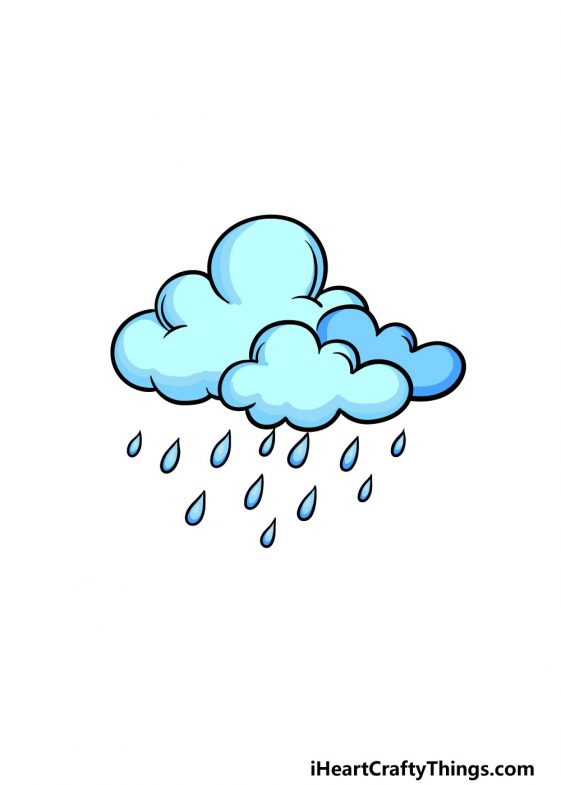Rain Sketch Drawing
As the world’s climate changes, our relationship with the rain has been transformed. Where once we might have seen a rainy day as a nuisance to be avoided, now as we face global water scarcity, the gift of rain has taken on a deeper meaning. Rain is no longer simply an inconvenience, but an essential element of our planet’s ecosystem.
For centuries, rain has inspired writers, artists, and musicians to capture its beauty and power. From the gentle patter of a summer shower to the thundering roar of a monsoon downpour, rain has become a symbol of life, growth, and renewal. But how much do we really know about the science behind this essential element?
At its most basic level, rain is simply water that falls from the sky. But the process by which rain is formed is anything but simple. Rain begins as water vapor in the atmosphere, which eventually condenses into droplets and falls to the ground. This process is known as the water cycle, and it is critical to the health and survival of our planet’s ecosystems.
One of the most fascinating things about rain is the enormous variety of shapes and sizes that raindrops can take. From large, heavy drops that pelt the ground with force to tiny droplets that seem to dance in the air, each raindrop is unique. The shape and size of raindrops is determined by a number of factors, including the temperature and humidity of the air, as well as the strength of the wind.
Scientists have long been fascinated by the way in which raindrops form and fall from the sky, and much research has been done to try to understand this complex process. One of the most interesting things about rain is the way in which it interacts with the natural environment. For example, the sound of rain falling on leaves and other surfaces has been shown to provide a calming effect, reducing stress and promoting relaxation.
Another interesting aspect of rain is the way in which it affects our daily lives. From the way we dress to the activities we engage in, rain has an impact on almost every aspect of our existence. For example, rainy days can be the perfect excuse to stay indoors and curl up with a good book or catch up on our favorite TV shows. On the other hand, rain can also provide the perfect backdrop for outdoor adventures, such as hiking or camping.
Despite the many benefits of rain, however, it is not without its downsides. For example, heavy rainfall can lead to flooding, causing damage to homes, businesses, and entire communities. In addition, too much rain can also have a negative impact on agriculture, leading to crop failure and food shortages.
Given the many ways in which rain affects our lives, it is important to understand how to prepare for and cope with rainy weather. One of the most important things to remember is to always have the right gear on hand. This might include a waterproof jacket, sturdy rain boots, and an umbrella.
In addition, it is important to be aware of the risks associated with heavy rainfall, particularly in areas prone to flooding. Be sure to listen to weather alerts and follow any evacuation orders issued by local authorities. And if you live in an area prone to drought, be sure to do your part to conserve water and reduce your water usage whenever possible.
How to Survive a Rainstorm
Here are a few tips to help you make it through a rainy day:
- Stay inside as much as possible. This is especially important if you live in an area prone to flooding.
- Keep a supply of non-perishable food, water, and other essentials on hand in case of an emergency.
- Make sure your house is well-protected against the elements. This might include installing storm shutters, reinforcing your roof, and sealing any leaks in your windows or doors.
- Keep an eye on weather reports and be prepared to evacuate if necessary.
- If you must be outside, be sure to wear waterproof clothing and shoes.
- Avoid walking or driving in flooded areas, and never attempt to cross a flooded river or stream.
Tips for Staying Dry on a Rainy Day
If you do find yourself caught in a rainstorm, here are a few tips to help you stay dry:
- Wear waterproof or water-resistant clothing, including a raincoat or jacket, waterproof boots or shoes, and an umbrella.
- Avoid wearing heavy fabrics that absorb moisture, such as cotton or wool.
- Stay indoors as much as possible.
- Use public transportation or a rideshare service instead of walking or biking.
- Keep a spare set of clothes and shoes at work or in your car.
In conclusion, rain is one of the most fascinating and complex elements of our planet’s ecosystem. From its impact on our daily lives to its interaction with the natural environment, rain is truly an essential and inspiring force. By understanding the science behind rain and learning how to prepare for and cope with rainy weather, we can better appreciate the incredible power and beauty of this essential element.


Post a Comment for "Rain Sketch Drawing"